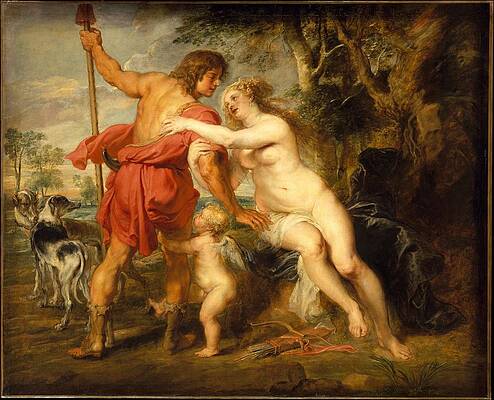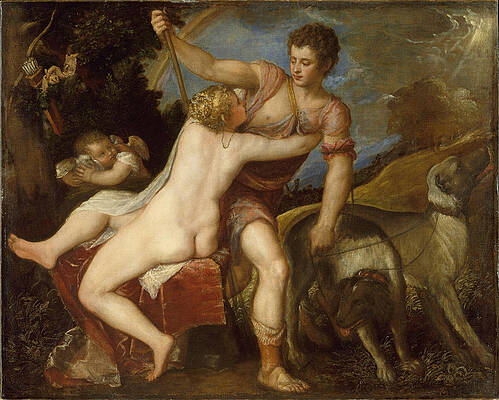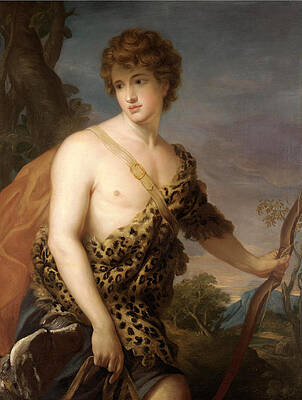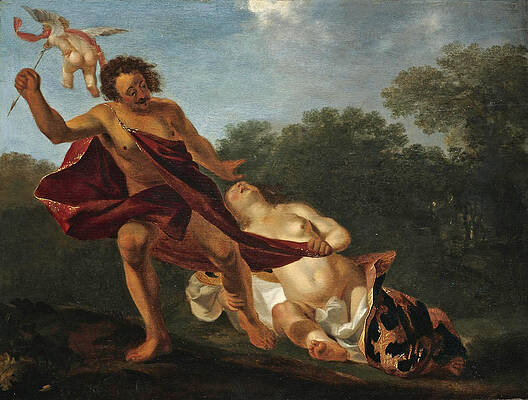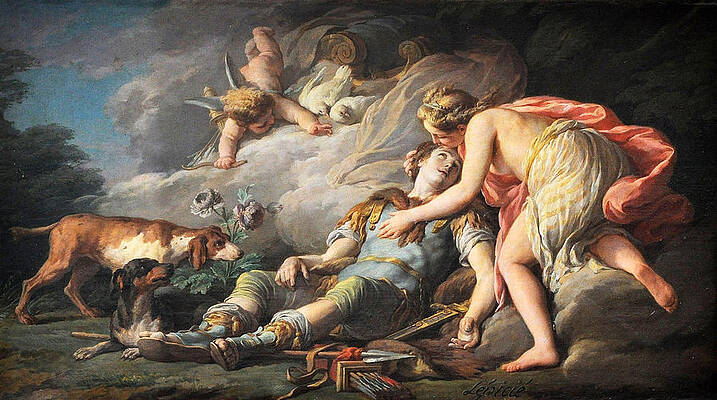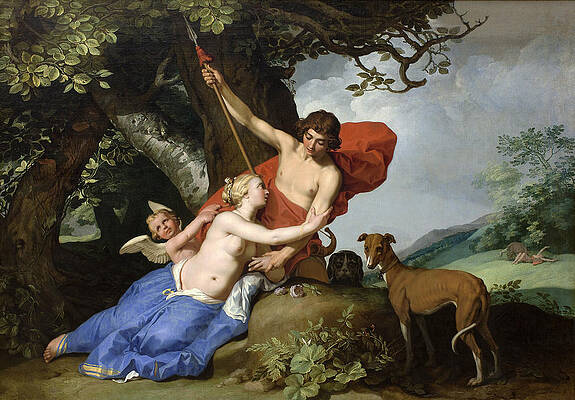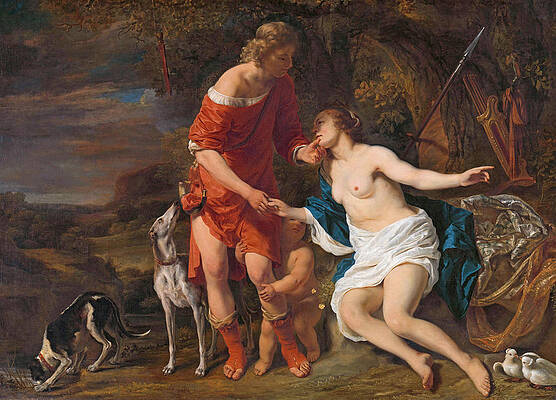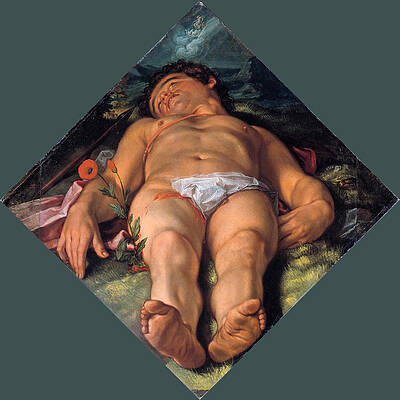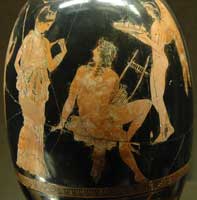
Aphrodite and Adonis, Louvre MNB2109
Adonis ( Άδωνις), a Syrian dying-and-reborn annual vegetation god imported into Greek mythology but always retaining aspects of his Semitic Near Eastern origins, Adonis was one of the most complex cult figures in classical times. He had multiple roles and there has been much scholarship over the centuries of his meaning and purpose in the Greek religious beliefs. His Semitic counterpart is Tammuz. His Etruscan counterpart was Atunis. He is an annually-renewed, ever-youthful vegetation god, a life-death-rebirth deity whose nature is tied to the calendar. His cult belonged to women: the cult of dying Adonis was fully-developed in the circle of young girls around Sappho on Lesbos, about 600 BC, as a fragment of Sappho reveals.
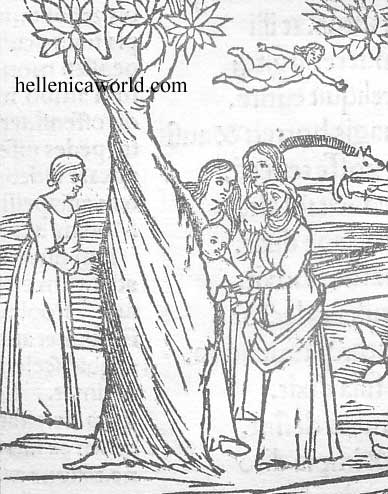
Birth of Adonis
Adonis was certainly based in large part on Tammuz. His name is Semitic, a variation on the word meaning "lord" that was also used, as "Adonai", to refer to Yahweh in the Old Testament. When the Hebrews first arrived in Canaan, they were opposed by the king of the Jebusites, Adonizedek, whose name means "lord of Zedek" (Jerusalem). Yet there is no trace of a Semitic cult directly connected with Adonis, and no trace in Semitic languages of any specific mythemes connected with his Greek myth; both Greek and Near Eastern scholars have questioned the connection (Burkert, p 177 note 6 bibliography). The connection in cult practice is with Adonis' Mesopotamian counterpart, Tammuz:
"Women sit by the gate weeping for Tammuz, or they offer incense to Baal on roof-tops and plant pleasant plants. These are the very features of the Adonis cult: a cult confined to women which is celebrated on flat roof-tops on which sherds sown with quickly germinating green salading are placed, Adonis gardens... the climax is loud lamentation for the dead god." —Burkert, p. 177).
Venus and Adonis, Peter Paul Rubens
Venus and Adonis, Titian

Adonis , National Museum Naples
Adonis was worshipped in unspoken mystery religions: not until Imperial Roman times (in Lucian of Samosata, De Dea Syria, ch. 6 [1] (http://www.geocities.com/SoHo/Lofts/2938/deasyria1.html)) does any written source mention that the women were consoled by a revived Adonis. Women in Athens would plant "gardens of Adonis" quick-growing herbs that sprang up from seed and died. The Festival of Adonis was celebrated by women at midsummer by sowing fennel and lettuce, and grains of wheat and barley. The plants sprang up soon, and withered quickly, and women mourned for the untimely death of the vegetation god (Detienne 1972).
As "Lord" or baal, Adonis was the youthful consort of the ageless Goddess, who might take various identities according to which aspect of annual renewal is being emphasized.

The Awakening of Adonis, John William Waterhouse
Birth of Adonis
Adonis' birth is shrouded in confusion for those who require a single, authoritative version. The resolutely patriarchal Hellenes sought a father for the god, and found him in Byblos and Cyprus, faithful indicators of the direction from which his cult had come. Walter Burkert questions whether Adonis had not from the very beginning come to Greece with Aphrodite (Burkert 1985, p. 177).
Multiple versions of the birth of Adonis exist: The most commonly accepted version is that Aphrodite urged Myrrha or Smyrna to commit incest with her father, Theias, the King of Smyrna or Syria, which confirm the area of Adonis' origins. Myrrha's nurse helped with the scheme, and Smyrna coupled with her father in the darkness. When Theias discovered this deception at last, by means of an oil lamp, he flew into a rage, chasing his daughter with a knife. Myrrha fled from her father, and Aphrodite turned her into a myrrh tree. When Theias shot an arrow into the tree, or when a boar used its tusks to render the tree's bark. Adonis was born from the tree, confirming his nature both as a vegetation god and as coming from the hot foreign desert lands where the myrrh tree grew. (It was not to be seen in Greece.)
Apollodorus (3.182) considered Adonis to be the son of Cinyras, of Paphos on Cyprus, and Metharme.
Hesiod, in a fragment, believes he is the son of Phoenix and Aephesiboea.
As soon as Adonis was born. the baby was so beautiful that Aphrodite placed him in a closed chest, which she delivered for security to Persephone, who was also entranced by his unearthly beauty and refused to give him back. The argument between the two goddesses was settled, either by Zeus or Calliope, with Adonis spending four months with Aphrodite, who seduced him with the help of Helene, her friend, four months with Persephone and four months of the years with whomever he chose. He always chose Aphrodite because Persephone was the cold, unfeeling goddess of the Underworld.
Adonis died at the tusks of a wild boar, sent by either Artemis or Aphrodite's lover, Ares, who was jealous of Adonis' beauty. As Aphrodite sprinkled nectar on his body, each drop of Adonis' blood turned into a blood-red anemone, and the river Adonis (modern Nahr Ibrahim) flowing out of Mount Lebanon in coastal Syria ran red, according to Lucian (chs. 6 – 9) who, attributes the color to siltation, but adds "Nonetheless, there are some inhabitants of Byblos who say that Osiris of Egypt lies buried among them, and the mourning and the ceremonies are all made in honor of Osiris instead of Adon" [2] (http://www.geocities.com/SoHo/Lofts/2938/deasyria1.html). Certainly there are many parallels with the myth of Osiris, encased in the coffin, imprisoned in the tree from which he issues forth.
"In Greece" Burkert concludes, "the special function of the Adonis cult is as an opportunity for the unbridled expression of emotion in the strictly circumscribed life of women, in contrast to the rigid order of polis and family with the official women's festivals in honour of Demeter."
His name is frequently used as an allusion to an extremely attractive, youthful male, often with a connotation of immature vanity: "the office Adonis."
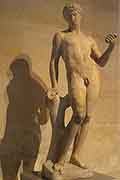
"Shakespeare has a poem called Venus and Adonis. Shelley calls his elegy on the poet Keats Adonais, under the idea that the untimely death of Keats resembled that of Adonis"
Adonis, James Northcote
Adonis taking leave of Venus, Abraham van Cuylenborch
Adonis Transformed by Venus Into an Anemone, Nicolas Bernard Lepicie
The Death of Adonis with Venus Cupid and the Three Graces, Peter Paul Rubens
Venus and Adonis, Abraham Bloemaert
Venus and Adonis, Ferdinand Bol
Venus and Adonis, Theodoor van Thulden
Venus trying to prevent Adonis from going hunting, Karel Dujardin
Venus and Amor Mourning the Death of Adonis, Cornelis Holsteyn
Dying Adonis,
Hendrik Goltzius
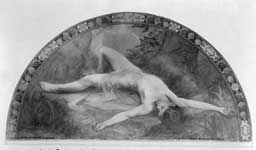

Venus and Adonis, Jacopo Amigoni
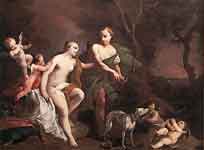
Venus and Adonis, Jacopo Amigoni
Venus und Adonis , Paolo Veronese , c. 1580

Venus and Adonis, Annibale Carracci
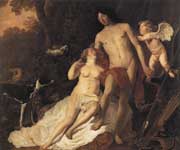
Venus and Adonis, Jacob Adriaensz Backer

Venus and Adonis, Petr Sokolov
Venus and Adonis , Joseph Heintz the Elder after 1603
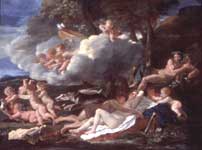
Venus and Adonis, Nicolas Poussin
Venus and Adonis, Sebastiano Ricci
Venus, Adonis and Amor, Dirk de Quade van Ravesteyn, 1589/1619
Venus and Adonis, Giuseppe Cesari
Venus and Adonis. François Le Moine ( Lemoyne) 1729
Death of Adonis, Anton Losenko 1764
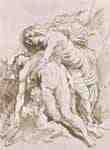
The Death of Adonis, Peter Paul Rubens
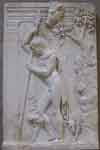
Death of Adonis , Julius Troschel
Venus and Adonis, W. Strang
Further reading
Greek Religion, Walter Burkert
Detienne, Marcel, 1972. Les jardins d'Adonis, translated by Janet Lloyd, 1977. The Gardens of Adonis, Harvester Press.
Gods of the Greeks, Carl Kerenyi
See also : Greek Mythology. Paintings, Drawings
Retrieved from "http://en.wikipedia.org/"
All text is available under the terms of the GNU Free Documentation License
| Ancient Greece
Science, Technology , Medicine , Warfare, , Biographies , Life , Cities/Places/Maps , Arts , Literature , Philosophy ,Olympics, Mythology , History , Images Medieval Greece / Byzantine Empire Science, Technology, Arts, , Warfare , Literature, Biographies, Icons, History Modern Greece Cities, Islands, Regions, Fauna/Flora ,Biographies , History , Warfare, Science/Technology, Literature, Music , Arts , Film/Actors , Sport , Fashion --- |

